Beeston railway station
Beeston railway station is a Grade II listed[1] railway station on the Midland Main Line which serves the town of Beeston in Nottinghamshire, England. It lies 3.2 miles (5.1 km) south-west of Nottingham railway station, and 750 metres (0.5 mi) south-east of Beeston transport interchange for local buses and Nottingham Express Transit trams. The station is managed by East Midlands Railway.
Beeston | |
|---|---|
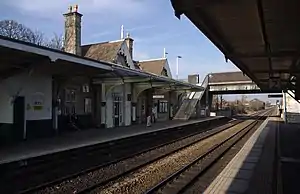 Beeston Station in 2012 | |
| General information | |
| Location | Beeston, Broxtowe England |
| Grid reference | SK533362 |
| Managed by | East Midlands Railway |
| Platforms | 2 |
| Other information | |
| Station code | BEE |
| Classification | DfT category D |
| History | |
| Opened | 1839 |
| Passengers | |
| 2017/18 | |
| Interchange | |
| 2018/19 | |
| Interchange | |
| 2019/20 | |
| Interchange | |
| 2020/21 | |
| Interchange | |
| 2021/22 | |
| Interchange | |
Listed Building – Grade II | |
| Feature | Beeston Railway Station, including the canopy to platform one and shelters on platforms one and two |
| Designated | 11 March 1987 (amended 5 December 2014) |
| Reference no. | 1247961[1] |
| Notes | |
Passenger statistics from the Office of Rail and Road | |
Description
Beeston station is on the Midland Main Line, 123 miles 22 chains (198.4 km) from London, on the spur towards Nottingham.[2] There are two platforms: platform 1 to the north for trains towards Nottingham and Lincoln and platform 2 to the south for trains towards London, Leicester, Birmingham and Derby. The platforms may be accessed either by steps from the Station Road bridge or by short ramps from Station Road for Platform 1 or Technology Drive for Platform 2.
Services
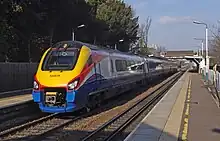
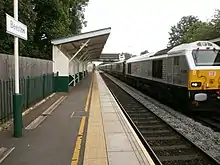
Services at Beeston are provided by East Midlands Railway and CrossCountry, with the former providing most services and managing the station. There are usually 4 trains per hour from each direction.
Two East Midlands Railway running between London and Nottingham go through Beeston, one of which (via Loughborough, Leicester, Market Harborough, Kettering, Wellingborough, Bedford and Luton Airport Parkway) calls in each direction, as do the Leicester-Lincoln Central via Newark Castle and the Newark Castle/Nottingham-Matlock via Derby services.
The hourly CrossCountry Nottingham-Birmingham New Street via Derby service also stops here, along with a few through trains to/from Cardiff Central. There is also a single daily direct CrossCountry southbound only service to Bournemouth via Derby, Birmingham New Street and Reading.[3]
| Preceding station | Following station | |||
|---|---|---|---|---|
| Long Eaton | CrossCountry Birmingham - Nottingham |
Nottingham | ||
| Derby | CrossCountry Nottingham to Bournemouth (Limited service, southbound only) |
|||
| Attenborough | East Midlands Railway Derwent Valley Line |
|||
| East Midlands Parkway | East Midlands Railway Leicester - Lincoln |
|||
| East Midlands Parkway | East Midlands Railway Midland Main Line |
|||
Facilities
Passenger numbers using the station have risen substantially in recent years, facilities include: a ticket office and ticket vending machines, a café, bicycle racks, car parking and taxi rank.[4]
The Derby-Nottingham section of Route 6 of the National Cycle Network passes by the station and provides a traffic free cycle route to the University of Nottingham.
Network Rail have a long-term aspiration to extend both platforms by up to 69 metres.[5]
East Midlands railway have a long-term aspiration to provide lifts at Beeston railway station.[6]
History
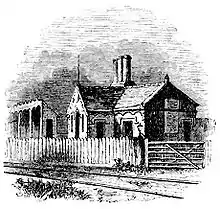
The station was built in 1839 for the Midland Counties Railway.[7] Services began on 4 June 1839. In 1844 the Midland Counties Railway joined with the North Midland Railway and the Birmingham and Derby Junction Railway to form the Midland Railway.
The first station from Nottingham, at the time it was very popular with people from the city who wished to spend a day in the countryside, desiring "fresh air and recreation".
The original station building, which was little more than a cottage, was replaced in 1847 with the substantially larger white brick building with ashlar trimmings which still exists. This is notable for its carved bargeboards, some remaining diagonal paned windows and the pseudo-heraldic shields with 'MR' and '1847'.[8] The wooden platform canopies and adjacent wrought-iron and glass canopy were installed in 1871. The wooden platform canopies were originally located at Southwell railway station, and were relocated to Beeston when Southwell was rebuilt.[9]
The growth of Beeston led to substantial expansion of the station facilities in the Edwardian period. An extension containing a large booking hall, ladies' waiting room and parcels office was added to the rear of the station building, doubling its floorspace.
_railway_station.jpg.webp)
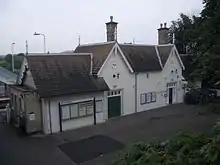
In 1937 the Midland Railway drew up plans for an additional waiting room on platform 2 but the plan was never put into action.
Post-WWII
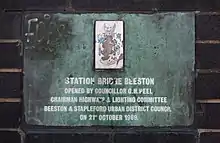
The level crossing, lattice footbridge and signal box survived until 1969 when Beeston and Stapleford Urban District Council built a road bridge ("Station Bridge") across the railway to ease traffic delays caused by the frequent closure of the level crossing. This effectively replaced the footbridge between the two platforms.
With the decline in passenger numbers in the 1980s, the entire station suffered from vandalism and neglect, and British Rail proposed complete demolition. A spirited campaign by the local civic society and rail historians led to the listing of the station building in 1987. A separate listing application was made in the early 1990s and the platform shelters were also listed. This was followed by restoration of what remained of the 1847 building and the platform shelters. The (architecturally undistinguished) extension was demolished, revealing the original gables on the north side of the building.
The original platform masonry survived until 2004 when the platforms were completely rebuilt.
 28 January 2004
28 January 2004 5 February 2004
5 February 2004 6 February 2004
6 February 2004 18 February 2004
18 February 2004 18 February 2004
18 February 2004 Rebuilt platforms, 21 July 2005
Rebuilt platforms, 21 July 2005
Nottingham remodelling scheme
Between 20 July and 25 August 2013, the services from the station were reduced because of the Nottingham remodelling and resignalling scheme.[10] It acted as a terminus for trains from London via East Midlands Parkway and from Derby, with a frequent rail-replacement shuttle bus running to and from Nottingham while the western end of the station and approach lines were remodelled.
Beeston station staff
Station Masters
| Date | Name | Notes |
|---|---|---|
| ca 1839 | Mr. Campbell[11] | |
| ca 1844 | Jonathan Raven[12] | Described in the Nottinghamshire Directory as Station Keeper |
| ca 1848 | Joseph Tipper | |
| 1850 - 1854 | John Swain | |
| ca. 1861 - 1864[13] | Frederick Musson | Discharged in 1864 |
| 1864 - 1865[13] | John Pick | Formerly station master at Fiskerton |
| ca 1867 | Arthur Montague Keighley | Formerly station master at Bredon |
| Dec 1869 - 1883 | Samuel Theodore Bunning | His salary was 24 shillings per week. Here he remained for over 13 years and received advances for 9 years until his salary nearly doubled to £120 per annum. |
| 1883 - 1892[14] | William Foster[15] | Formerly at Alfreton station. Afterwards stationmaster at Trent Junction |
| 1892 - 1920 | John Williams[16] | Formerly station master at Syston |
| 1920 - 1929 | Alfred Marston[17] | Afterwards station master at Buxton |
| 1929 - 1933 | G. Bradshaw[18] | Formerly station master at Wem, Salop, afterwards station master at Buxton |
| 1933 - 1942 | Harold Smith[19] | Formerly station master at Sheepsbridge, Chesterfield |
| 1942 - 1947 | William Jinks[20] | Formerly station master at Chesterfield |
| 1947 - 1956 | F. Richardson[21] | |
| 1956 - ???? | H. Robinson[22] | Formerly station master at Mytholmroyd |
1881 census
The railway employed a large number of local people. The 1881 census for Beeston[23] shows 141 men with railway employment although there is no evidence that they all worked in Beeston.
Miscellaneous
In 1864, John Ashe is listed as the booking clerk.
Leslie Blood worked in the booking office from 1926 to 1939 when he was promoted to the position of Stationmaster at Stoke Golding.
Sir Neil Cossons, now Chairman of English Heritage, worked as a junior porter in his youth.
Station Master's House
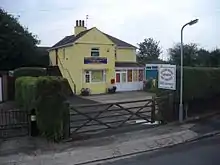
- The first station masters house built in 1839 was a small cabin.
- A larger building, originally at Southwell was moved to Beeston and erected in 1857.
- The Station Master's House at 211 Station Road is now private property, used as Station House Children's Day Nursery.
Other information
- The Victoria Hotel public house is adjacent to the Nottingham platform and has its own gate access to the platform, for which it reputedly paid an annual peppercorn rent of 50 pence. The gate was locked out of use for a number of years, so access to the Victoria Hotel was via Technology Drive or Barton St, however it was opened for access again in 2014.
- There was also a Beeston Castle and Tarporley railway station in Cheshire, England, for the villages of Beeston and Tarporley. Between 1840 and 1868 it was called simply "Beeston".
References
- Historic England, "Beeston Railway Station, including the canopy to platform one and shelters on platforms one and two (1247961)", National Heritage List for England, retrieved 30 December 2016
- Yonge, John (March 2005) [1990]. Jacobs, Gerald (ed.). Railway Track Diagrams 4: Midlands & North West (2nd ed.). Bradford on Avon: Trackmaps. map 6A. ISBN 0-9549866-0-1.
- GB eNRT May 2016 Edition, Tables 53, 56 & 57 (National Rail)
- "125MPH TRAINS TO CUT JOURNEY TIMES". Nottingham Evening Post. 12 April 2008.
- "Network Rail CP4 Delivery Plan 2009 Enhancements programme: statement of scope, outputs and milestones" (PDF). Network Rail. Archived from the original (PDF) on 7 June 2011. Retrieved 18 March 2010.
- "Making Rail Accessible, Policies and Procedures" (PDF). London: East Midlands Trains. January 2011. p. 9. Retrieved 13 October 2011.
- The Nottingham and Derby Railway Companion. Foreword by J.B. Radford. Derbyshire Record Society. 1979 [1839].
{{cite book}}: CS1 maint: others (link) - Higginson, M. (1989). The Midland Counties Railway: A Pictorial Survey. Derby: Midland Railway Trust.
- Leleux, Robin (1976). A Regional History of the Railways of Great Britain. Vol. 9 The East Midlands. ISBN 0-7153-7165-7.
- Network Rail. "Rebuilding Nottingham's railway" (Press release). Archived from the original on 26 July 2013. Retrieved 26 July 2013.
- 1839 Nottingham Directory
- 1844 Nottingham Directory
- "1859-1866". Midland Railway Miscellaneous Depts: 123. 1914. Retrieved 12 February 2021.
- "The Promotion of the Beeston Station Master". Nottinghamshire Guardian. England. 17 September 1892. Retrieved 7 December 2017 – via British Newspaper Archive.
- "Removal of the Alfreton Station-Master". Sheffield Independent. England. 30 January 1933. Retrieved 27 December 2016 – via British Newspaper Archive.
- "Syston". Leicester Chronicle. England. 16 July 1892. Retrieved 7 December 2017 – via British Newspaper Archive.
- "Midland Railway Station-Masters". Derbyshire Advertiser and Journal. England. 25 June 1920. Retrieved 27 December 2016 – via British Newspaper Archive.
- "Number of Changes in Derby Area". Nottingham Evening Post. England. 14 November 1933. Retrieved 27 December 2016 – via British Newspaper Archive.
- Nottingham Evening Post. 29 November 1946. p. 1.
{{cite news}}: Missing or empty|title=(help) - "Mr. W. Jinks". Nottingham Journal. England. 14 October 1947. Retrieved 7 December 2017 – via British Newspaper Archive.
- "New Beeston Stationmaster". Nottingham Journal. England. 30 October 1947. Retrieved 7 December 2017 – via British Newspaper Archive.
- "New Stationmaster at Mytholmroyd". Halifax Evening Courier. England. 25 April 1956. Retrieved 6 February 2021 – via British Newspaper Archive.
- Public Records Office, 1881 Census of England and Wales